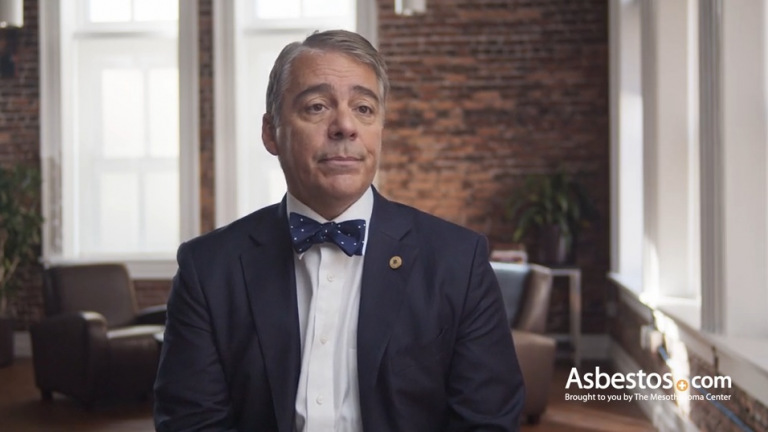Jayda was most likely exposed as a child through her father, who worked with asbestos products. This kind of asbestos exposure, when an asbestos worker unknowingly brings asbestos home on their clothing and work gear, is called secondary exposure. Jayda has four siblings, and she’s concerned about their potential prior exposure and what the future may hold.
Secondary Asbestos Exposure & Mesothelioma
Secondary asbestos exposure occurs when people who work with asbestos products carry the fibers home on their clothes, hair or skin. Like primary exposure, secondhand exposure can cause mesothelioma and other serious diseases. These illnesses have a latency period of decades before symptoms appear.
What Is Secondary Asbestos Exposure?
Secondary asbestos exposure is contact with fibers from someone who had primary exposure, often through work. You can inhale the fibers during everyday tasks like hugging them, doing their laundry, cleaning or sharing a home.
Also known as secondhand, domestic or household exposure, this type of asbestos exposure is just as dangerous as primary exposure. Secondary exposure also causes mesothelioma, lung cancer and asbestosis.
Key Facts About Secondary Exposure
- A Journal of Lung Health and Diseases study found 30% of mesothelioma cases in the U.S. are the result of secondhand exposure.
- Most household asbestos exposures happen among women, according to the American Journal of Industrial Medicine.
- Washing clothes covered in asbestos fibers raises the risk of developing mesothelioma or other asbestos-related diseases.
A historic report in the British Journal of Industrial Medicine featured the case study of a shipyard machinist’s wife who developed mesothelioma from washing her husband’s dusty work clothes. He told researchers his clothes were often “covered with [asbestos] dust.” She was found to have as many asbestos fibers in her lungs as concentrations associated with occupational exposure. This case study helped shape our understanding of the seriousness of secondary exposure.
Today, this secondary exposure is becoming less common thanks to the phasing out of asbestos use and tightened asbestos regulations. However, there are still exposure risks. And mesothelioma has a long latency period. It can take 20 to 60 years from initial exposure to the development of symptoms.
How Does Secondary Asbestos Exposure Occur?
Secondary asbestos exposure usually happens when tiny asbestos fibers are carried home from work on clothes, body, hair, skin or shoes. Entering your home with these fibers, they can easily then stick to furniture, carpeting and bedding. Hugs, sitting on a parents’ lap or doing their laundry are common ways this type of exposure happens.
People who work directly with asbestos-containing products and share workspaces with others can also accidentally put them at risk of secondary exposure. Desk chairs, particularly if they’re upholstered, and work vehicles can easily become contaminated with asbestos fibers. This type of exposure is also known as environmental asbestos exposure.
Jayda K., a peritoneal mesothelioma survivor, tells us her father worked in a lab at a coal mine where he used and tested asbestos products and worked with asbestos parts on the machinery at the coal mine. She says she initially had a hard time convincing doctors she was sick as her risk of secondary exposure wasn’t considered.
She tells us, “I had a really hard time convincing someone that I was in pain. You are your own best advocate. You are your own expert. You know your body better than anybody else does. And if something doesn’t feel right, scream it from the rooftops until somebody listens to you.”
Asbestos Brought Home on Clothing
Workers unknowingly carry asbestos fibers on their clothing after a day’s work. A study in the International Journal of Environmental Research and Public Health shows workers with the highest risk of bringing asbestos home included asbestos product manufacturing workers, insulators, shipyard workers and asbestos miners. Family members can be exposed when laundering their contaminated clothes.
Dr. Marcelo DaSilva, a thoracic surgeon at Advent Health Orlando, says, “I can think of at least three or four patients in which I’ve operated on” who were highly exposed to asbestos by a family member.
Contaminated Personal Items
Shoes, work bags and tools may also collect asbestos fibers. These items can easily transport asbestos into the home or office, creating a dangerous environment for household members and co-workers.
Another common way home exposure occurs is through furniture and fabrics like carpeting, upholstered headboards, couch fabrics and curtains. Fibers transported into the home quickly become embedded in these materials and can transfer to others or become airborne and inhaled.
Risk to Family Members
Spouses, children and other household members are often exposed when they come into contact with contaminated clothes or personal items. Even close physical interactions with a worker can result in exposure over time, significantly increasing health risks.

Understand your diagnosis, top doctors and ways to afford care.
Get Your Free GuideWhat Are the Health Risks of Secondary Asbestos Exposure?
Secondary asbestos exposure can cause mesothelioma, lung cancer, pleural plaques and asbestosis. Secondary exposure risks are the same as primary exposure, including pleural plaques and pleural effusions.
In some circumstances, secondary exposures have approached occupational levels. This is more likely to happen when a worker is employed in a high-exposure industry. Examples include asbestos miners, insulators, shipyard workers and construction workers.
Extensive research has proven that secondary asbestos exposure causes serious health effects. About 90% of all cases of malignant mesothelioma stem from asbestos exposure.
The number of yearly deaths from malignant mesothelioma in women saw a 25% increase from 1999 to 2020. Some experts suggest this may result from increased secondhand exposure, though women have also entered more fields that could lead to primary exposures.
Mesothelioma and Lung Cancer
Secondary asbestos exposure can cause mesothelioma, an aggressive form of cancer affecting the lungs and abdomen. It can also lead to lung cancer, with the same severity as those exposed firsthand.
Asbestosis
Asbestosis is a chronic lung disease caused by inhaling asbestos fibers. Prolonged direct or secondary exposure leads to lung scarring and breathing difficulties.
Why Secondary Exposure Is Often Undiagnosed
Secondary exposure cases are frequently misdiagnosed or identified too late because people may not realize they’ve been exposed. This can delay treatment, worsening the prognosis for those affected by asbestos-related diseases.
How to Protect Yourself From Secondary Exposure
It’s crucial to protect yourself and your family from secondary asbestos exposure. If someone in your home works in a higher-risk job like construction, shipyards or manufacturing, taking precautions to protect yourself from the risk of mesothelioma is critical.
Preventing Secondhand Asbestos Exposure
- Change clothes before coming home: Change at the job site to prevent bringing asbestos into your living space.
- Isolate contaminated items: Store shoes, tools and work bags in a designated area at work to prevent asbestos from entering personal spaces.
- Wash work clothes separately: If washing contaminated clothing at work isn’t an option and they must be brought home, take special care when handling them and keep them away from your family’s other laundry to avoid spreading fibers.
- Wear protective gear: Use masks, gloves and other protective clothing when handling asbestos.
To lower risk, workers should change out of contaminated work clothes before leaving their job site. Wearing protective gear like respirators and disposable coveralls can also help. Showering and washing their hair before coming home can also help prevent secondary asbestos exposure.
For more information on safety standards, consult the Occupational Safety and Health Administration (OSHA) and the Environmental Protection Agency (EPA). These organizations offer guidelines and regulations for minimizing asbestos exposure at work and at home.
Get Your Free Mesothelioma Guide

Find a Top Mesothelioma Doctor

Access Help Paying for Treatment

Legal Options for Secondary Asbestos Exposure
Juries in several states have awarded mesothelioma compensation to people who developed this cancer from secondary asbestos exposure and filed lawsuits. However, New Jersey and North Dakota recently denied secondary exposure claims. An experienced asbestos lawyer can help assess your legal options and how to prove your exposure.
Historic secondary exposure rulings have set important precedents. For example, in 2016, the California Supreme Court ruled companies are responsible for secondary asbestos exposure after 2 landmark lawsuits.
Notable Secondary Exposure Lawsuits
- $32 million: A South Carolina jury awarded Robert Weist, the surviving spouse of Kathy Weist, this amount in 2021. Kathy developed mesothelioma from secondary exposure. Her husband, father and uncle worked with asbestos products.
- $27.5 million: John Panza Jr.’s father worked with asbestos products for 30 years. John Jr. received a diagnosis of mesothelioma in 2012 at the age of 40 and received this verdict in 2013.
- $17.2 million: A jury awarded Craig and Deanne Warren this amount in 2022. Deanne’s husband’s work with asbestos products caused her secondary exposure and mesothelioma.
- $10.3 million: Henry Pete developed malignant mesothelioma after childhood exposure when his father came home from work covered in asbestos dust. He died before collecting compensation from his 2023 lawsuit. His son awaits the jury award.
- $1.1 million: A Seattle King County Court jury awarded Phyllis Granville this amount in 2013 after developing mesothelioma. She came in contact with dust while laundering her husband’s contaminated work clothes.
People who start showing symptoms of mesothelioma should seek a diagnosis as soon as possible. When their diagnosis is confirmed, it’s important to speak with a mesothelioma lawyer as soon as possible. They can help you gather all of the documentation you need to seek compensation that can help cover medical expenses and lost wages. As Registered Nurse and Patient Advocate Karen Selby says, “Just leave it in their hands… They’ll be able to figure it out.”
Common Questions About Secondary Asbestos Exposure
- What are other names for secondary asbestos?
-
There are several additional names for secondary asbestos exposure. These terms are often used interchangeably.
- Domestic exposure
- Familial exposure
- Household exposure
- Indirect exposure
- Paraoccupational exposure
- Secondhand exposure
- Take-home exposure
These terms describe exposures when someone is in contact with another person with primary asbestos exposure. Spouses and children typically experience secondary exposure.
- How much asbestos exposure is dangerous?
-
Any amount of exposure to asbestos is dangerous and can cause mesothelioma and other asbestos-related diseases. There is no safe level of exposure. However, a person’s risk level can increase depending on the frequency and concentration of asbestos contact. Long-term, repeated exposure can raise the risk of developing cancer like malignant mesothelioma.
- Can you sue for secondhand asbestos exposure?
-
Yes, you can file a lawsuit for secondhand asbestos exposure. However, secondhand legal claims aren’t as straightforward as direct exposure claims. A mesothelioma lawyer can investigate the source of asbestos and help family members file a successful claim.
- Can you wash asbestos out of clothes?
-
No, you can’t safely wash asbestos fibers out of clothing at home. Asbestos fibers resist water, heat and chemicals, so they stick to fabric and are very hard to remove. If you try to wash clothes covered in asbestos, you can spread the fibers to other clothes and even to the washing machine. The best thing to do is have the clothing professionally cleaned or throw it away.




